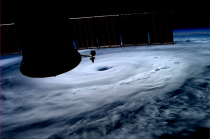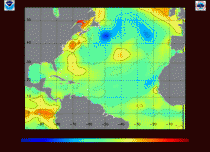Joseph D’Aleo, CCM in HLN
Hurricane Arthur (as viewed from the International Space Station) slammed the Outer Banks of NC and then brushed New England, contributed to the rains, well needed though untimely on the 4th.

Early this spring, we (weatherbell.com) predicted on this page and on our site that there would be more threats than normal to the east coast and New England this season despite the fact there would be overall less activity in the deep tropics and fewer storms that made their way from Africa (called Cape Verde storms). This was because of cooler than normal tropical water, dusty, dry air blowing off the Sahara into the high atmosphere, and increased vertical wind shear because of a developing El Nino. This shear is in the form of anomalous westerly winds at high levels that come east from the warm eastern Pacific and blow the tops off of thunderstorms that are trying to organize in waves moving west in the subtropical Atlantic.
The ocean from the Bahamas north off the east coast where the Gulf Stream carries warmth Poleward, is warmer than normal and is north of the unfavorable dry Saharan air and wind shear.

Atlantic sea temperature anomalies NHC Enlarged
_thumb.jpg)
Atlantic Saharan Dust layer CIMSS Enlarged

Atlantic vertical wind shear Enlarged
We forecast that old fronts or disorganized waves from the east would get their act together often closer to the mainland like Arthur did. Hurricane Carol, one of the worst New England storms organized over the Bahamas and slammed Long island and eastern New England in short order in 1954.
Arthur developed last week just off the southeast coast and feeding off the Gulf Stream, developed into a Category 2 hurricane crossing the Outer Banks of North Carolina before brushing New England in a weakened state. It brought some needed rains but is a potential omen of storms to follow.
The oceans and sun are the primary drivers to the climate regimes we find ourselves in when it comes to hurricanes, tornadoes, droughts and floods, heat and cold, and snowstorms. In terms of the ocean, the current combination of a cool Pacific and warm Atlantic Multidecadal modes is most like the 1950s. That was a period of drought in the southern Plains like the past few years, and a decade where 6 hurricanes created havoc on the Atlantic Coast. We had Carol, Edna, and Hazel in 1954, Connie and Diane in 1955 and Donna in 1960.
The ocean cycles average about 60 years and 60 years ago was the hurricane era of the middle 1950s.
A lesson from the 1950s is that you can have multiple landfalling storms in a season, even ones with a normal number of Atlantic named systems. As the Atlantic cooled, the flurry of landfalling storms ended in 1960 with Donna. The Atlantic warmed again in 1995 and the Pacific cooled after 1998. Floyd developed in 1999, Isabel made landfall in the Mid Atlantic in 2003, Irene hit New York and western New England in 2011 and Sandy, New Jersey and New York City in 2012. Arthur made a close pass this week and there may be more.
The Atlantic will cool within the next 5 years in its 60-year cycle and then both oceans will be cold. We can rest easier in the east in the summer and fall. Our winter temperatures will accelerate down though.
The 1960s and 1970s had the oceans go into their cold phase and the sun turn relatively quiet and the globe cooled. A series of volcanoes in the 1960s also contributed by creating an aerosol layer high up that reduced sunlight. There was also a concern about what was called “the human volcano”, man-made particulates that were also blocking sunlight. This is no longer an issue in the US with scrubbers on our coal plants and cleaner, more efficient cars, but a real one in China and India.
Some leading scientists and the government then warned of the possibility of a return to the little ice age conditions we experienced from the 1600s to early 1800s. The CIA in a 1974 report said “There is a growing consensus among leading climatologists that the world in undergoing a cooling trend… already causing major economic problems throughout the world.” Sound familar? See thisLeonard Nimoy video from 1978. “Climate experts believe the next ice age is on its way.”
Though Wikipedia will list reasons why this fear then never really happened, you can see evidence here that it did.
These factors cooled the globe then, but then from 1979 to 1998 when the sun rebounded and the oceans cycled back warm, the globe warmed again. Man has the arrogance to think we control the planet’s climate. We do play a role with urbanization, deforestation and locally where pollution is an issue but these effects are small and localized relative to the main, powerful natural forcings. See how US temperature cycles match to these cycles in the sun and ocean and not well with CO2, which has risen this whole period.
The solar has begun its downwards spiral after 1995, accelerating after 2000 and the oceans have begun cooling. Global warming has ceased for 12 to 20 years (depending on the data and region). As the Atlantic cools and all these three factors synchronize, look for temperatures to accelerate down. Throw in a major volcano (which can cool the earth a half degree) and we will have to cue Mr. Spock again.
We will cool like we did in the 1960s and 1970s, and, as we will explain in the next story, then potentially like the early 1800s. This will have major negative, even dangerous impacts on our region especially given the unwise and ultimately very costly energy policies of the EPA and state elected officials. Increasing energy prices also cause the cost of all goods and services to rise, increasing the stress further on those on fixed income and the poor and middle class. Dr. Frank Clemente of Penn State University explains the risk here in this IEA report.
----------
My talk at the Heartland was on the cold and snow on the increase (around minute 17)
Broadcast live streaming video on Ustream





